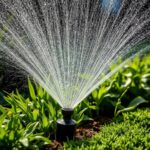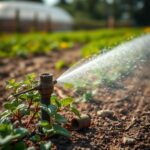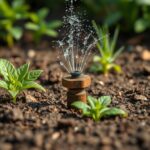What's the Difference Between Irrigation and Reticulation? A Comprehensive Guide to Understanding their Distinctions

In the realm of agriculture and landscaping, understanding the nuances between irrigation and reticulation is essential for optimal water management. While both systems are designed to distribute water effectively, each serves distinct purposes and operates differently. This comprehensive guide will delve into the key differences between irrigation and reticulation, exploring their definitions, methodologies, applications, and benefits. By the end of this article, readers will have a clearer grasp of how these two systems function and how to choose the right one for their specific needs, ensuring that plants receive the appropriate care for healthy growth.
What’s the Difference Between Irrigation and Reticulation?
Irrigation and reticulation are often used interchangeably in agricultural and landscaping contexts, yet they refer to distinct processes. Irrigation is a broader term that encompasses the artificial application of water to soil or land to assist in the growing of crops and vegetation, frequently involving methods like drip or sprinkler systems. On the other hand, reticulation specifically pertains to the design and layout of piping systems that distribute water in an efficient manner, ensuring that it reaches designated areas evenly. While irrigation focuses on the act of supplying water, reticulation is concerned with the infrastructure that facilitates this process.
Definition of Irrigation
Irrigation is defined as the controlled application of water to agricultural crops, landscapes, or soil to assist in the growth of plants. This method can vary significantly, using methods such as surface irrigation, where water flows over the land surface, or more advanced technologies like drip irrigation, which delivers water directly to the roots of plants, optimizing water use for maximum efficiency and reducing waste.
Definition of Reticulation
Reticulation refers to the network of pipes and channels that distribute water throughout a specified area, whether it be for agriculture, landscaping, or even municipal water supply. This system is designed to ensure that water is delivered efficiently and evenly, minimizing areas that receive too much or too little water, thus enhancing the effectiveness of irrigation practices.
Purpose of Irrigation
The primary purpose of irrigation is to provide supplemental water to areas where natural rainfall is insufficient for crop growth or where specific plants require controlled moisture conditions. This helps in increasing agricultural yield, ensuring food security, and enabling the cultivation of crops in regions with drought-prone climates, where natural water sources are limited.
See also:
Purpose of Reticulation
The purpose of reticulation is to ensure an effective distribution network for water that supports irrigation and other needs. By creating a well-planned reticulation system, it allows for better water management, reducing operational costs and improving access to essential water resources, thereby supporting both agricultural and urban environments.
Common Methods Used
Common methods of irrigation include surface irrigation, where gravity helps the movement of water; drip irrigation, which delivers water drop by drop at the root zone; and sprinkler systems, which mimic rainfall and cover large areas. Reticulation methods, however, focus more on the layout of pipes, including above-ground and underground designs, to optimize water flow and reduce wastage.
| Aspect | Irrigation | Reticulation |
|---|---|---|
| Definition | Application of water to assist plant growth. | Network of pipes that distributes water. |
| Focus | Water supply methods | Distribution infrastructure |
| Common Methods | Drip, surface, sprinkler | Piping systems |
| Main Purpose | Increase yield & growth efficiency | Efficient water distribution |
| Water Management | Supplement natural rainfall | Optimize delivery and minimize waste |
Understanding the Key Components of Irrigation and Reticulation
Irrigation and reticulation are two distinct methods of delivering water to plants, each with its unique characteristics and purposes. Irrigation generally refers to the overall process of supplying water to crops, whether through surface, subsurface, or overhead methods, aimed at enhancing agricultural productivity in various climates. In contrast, reticulation specifically denotes a network of pipes and channels that distribute water efficiently within a localized area, particularly in landscaping or garden settings. While both systems serve to optimize water usage and promote healthy plant growth, understanding their differences can significantly impact design decisions and resource management strategies in horticulture and agriculture.
The Historical Development of Irrigation Systems
The history of irrigation systems dates back thousands of years, when ancient civilizations developed techniques to manage water for agriculture. From the early civilizations of Mesopotamia and Egypt creating canals to modern innovations such as drip and sprinkler systems, the evolution of irrigation reflects the changing needs and technologies of societies. These systems have enabled farmers to cultivate crops in arid regions, significantly increasing food production and ensuring stable supplies for growing populations.
The Principles of Reticulation in Garden Design
Reticulation involves designing a system of pipes that deliver water to specific areas of a garden or landscape, ensuring every plant receives the necessary moisture. This method not only promotes uniform water distribution but also minimizes water wastage and reduces labor involved in manual watering. Effective reticulation systems are essential for maintaining healthy lawns and flower beds, allowing homeowners to manage their water resources efficiently while achieving beautifully maintained outdoor spaces.
See also:
Comparing Efficiency: Irrigation vs. Reticulation
When comparing the efficiency of irrigation and reticulation, three factors stand out: water usage, labor, and cost. Irrigation systems may cover larger areas, which can make them less efficient in delivering water precisely where needed. On the other hand, reticulation systems allow for targeted distribution, reducing both water waste and labor-intensive tasks. Ultimately, the choice between these systems should be based on the specific needs of the landscape or agricultural setup, weighing the initial investment against long-term savings.
Environmental Impact of Irrigation and Reticulation
The environmental implications of irrigation and reticulation cannot be understated. Irrigation, if not managed properly, can lead to issues such as waterlogging, salinization, and depletion of local water bodies. Conversely, reticulation systems, designed with sustainability in mind, promote efficient water use and can help to reduce runoff and erosion in sensitive environments. Understanding the environmental impact of these systems is essential for both agricultural practitioners and gardeners to ensure sustainable practices that conserve resources and protect ecosystems.
Future Trends in Irrigation and Reticulation Technology
Looking ahead, advancements in technology are poised to revolutionize both irrigation and reticulation. The integration of smart sensors, automated systems, and data analytics will enable more precise watering decisions, optimizing water usage based on real-time soil and weather conditions. These innovations promise to make both irrigation and reticulation more efficient and environmentally friendly, paving the way for the future of sustainable agriculture and landscape management.
Questions from Our Readers
What is irrigation?
Irrigation is the process of supplying water to land or crops to help in growth, primarily through the use of artificial methods such as channels, pipes, or sprinklers. The goal of irrigation is to ensure that plants receive the appropriate amount of moisture, which can be critical in areas with low rainfall or during dry seasons.
What is reticulation?
Reticulation refers to a network of pipes or channels that distribute water to various areas, specifically for irrigation or landscaping purposes. This system ensures that water is delivered efficiently and uniformly to different parts of a garden or agricultural field, promoting healthy plant growth and optimal water usage.
See also:
How do irrigation and reticulation differ?
While both irrigation and reticulation involve the delivery of water, irrigation is a broader term that encompasses the overall process of applying water to land, whereas reticulation specifically describes the network of pipes or channels used within that process. Essentially, reticulation is a subset of irrigation focused on the distribution aspect of water application.
Can reticulation be used without irrigation?
Yes, reticulation can be used for purposes other than irrigation, such as supplying water to gardens, lawn maintenance, or even for aesthetic water features. However, in a strict agricultural sense, reticulation is primarily designed to support irrigation systems by ensuring an even and efficient distribution of water to crops or plants.

If you want to read more articles like What's the Difference Between Irrigation and Reticulation? A Comprehensive Guide to Understanding their Distinctions, we recommend you check out our Irrigation category.
Leave a Reply
Related Articles